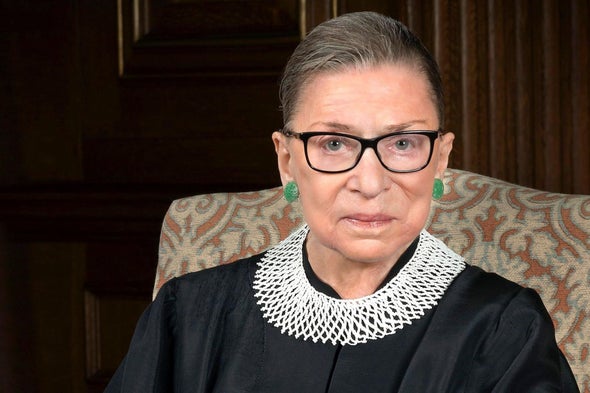Remembering Ruth: A Retrospective

November 6, 2020
After 27 years serving on the Supreme Court, Justice Ruth Bader Ginsburg, a powerful advocate for women’s rights, passed away on Sept. 18 due to complications from metastatic pancreatic cancer. As only the second woman appointed to the Supreme Court, her thoughtful, yet candid and vividly intelligent approach differing opinions made Justice Ginsburg a prominent figure in the pursuit of equality throughout the past several decades. Throughout her tenure on the Supreme court, her poignant dissenting opinions on some of the United States most influential Supreme Court cases have helped transform roles around gender in society.
Prior to Justice Ginsburg’s appointment to the Supreme Court, the US had never recognized sex discrimination as a matter of constitutional concern. Because of this, her early goals primarily consisted of persuading the Supreme Court that the 14th Amendment’s guarantee of equal protection did not solely pertain to racial discrimination, but applied to sex discrimination as well. To begin this process, Justice Ginsberg chose to argue for cases which clearly displayed the detrimental effects of laws which are built around the stereotyped notions of male and female capabilities. In a 1988 speech, she stated “The court first had to gain an understanding that legislation apparently designed to benefit or protect women could have the opposite effect.”
As a young woman, Ginsberg attended Cornell University as well as both Colombia and Harvard Law School. All of the schools that she attended had a minimal number of females in their student body, as it was unusual for women to receive a higher education during the 50’s. Defying the discrimination that she faced based on her gender, Ginsberg received top grades, outranking that of her male counterparts, while simultaneously taking care of her young child and the pressing illness of her husband. Although she was initially rejected from all of the law firms that she interviewed at due to her gender, she eventually worked as a teacher at Rutgers Law School and later became the first tenured female professor at Columbia Law School
Preceding her appointment to the supreme court, one of the most critical cases of Ginsberg’s career included Weinberger v. Wiesenfeld. This consequential case concerned a man who, following his wife’s death, had wanted to work less and stay home with his son, but found that he was not eligible for Social Security payments on account of his gender. Ginsburg went to court on his behalf and stated that the law, which created a distinction between mothers and fathers, was based on stereotyped notions of men and women’s role in the family, and was therefore unconstitutional. Ginsberg argued that by not providing him with the same survivors’ benefits as it would to a widow, the Social Security Act discriminated against Stephen Wiesenfeld. Her arguments eventually lead to the Supreme Court’s unanimous decision that the Social Security Act of 1935, which permitted widows but not widowers to collect special benefits while caring for children, violated the right to equal protection guaranteed under the Fifth Amendment.
In many of the landmark cases which Ginsburg argued, the plaintiff was a man; this strategy both worked to draw sympathy from the male-dominated Court, while starting to introduce the idea of how impactful sex discrimination could be to both men and women. In the United States, landmark cases are court decisions which substantially change the interpretation of existing law.
When President Jimmy Carter nominated Ginsburg to be a federal judge in 1980, many activists were surprised and even disappointed when Ginsberg turned out to be a very moderate judge. As a believer in judicial restraint, many of her rulings during this period often sided with conservatives, demonstrating what appeared to be centrist values. Her practice of impartiality continued after she was appointed to the Supreme Court.
However, following the retirement of Justice Sandra Day O’Connor, the court quickly became ideologically polarized. As the court moved farther to the right, Ginsburg’s dissents gradually grew bolder. Over time, her powerful opinions began to attract attention. Eventually a law student, Shana Knizhnik, gave her the nickname Notorious R.B.G., which is a play on the name of the famous rapper, Notorious B.I.G. This name, along with her iconic image, quickly became an internet sensation.
One of Ginsberg’s most famous dissents was in response to the Supreme Court’s decision to overturn the Voting Rights Act, on the grounds that it no longer had pertinence to society, since it had been written over 40 years ago. The Voting Rights Act, which had been enacted to address racial discrimination, outlawed discriminatory voting practices in the South by restricting states and local governments from implementing changes to their voting laws or practices, without first getting federal preclearance. Although she was not in a position to control the outcome of the case, Ginsberg’s famously lengthly, scathing dissent served as inspiration for many individuals, and was ultimately the beginning of her figure being viewed as a cultural icon.
It is extremely uncommon for Supreme Court justices to give interviews. When they do, it is typical to avoid strongly political topics. It was in part because of this that Ginsburg’s stardom only grew after her open criticism of Donald Trump during the 2016 presidential race, who was at the time, the presumptive Republican presidential nominee. In an interview, Ginsburg said, “He is a faker,” “He has no consistency about him. He says whatever comes into his head at the moment. He really has an ego.” Trump responded via Twitter by calling on Ginsburg to resign. Although she later apologized for her remarks, Ginsburg expressed no regrets or surprise at the criticism which she received for her comments, and instead elaborated on her criticism of Donald Trump.
Because Supreme Court Justices are tenured for life, Ruth Bader Ginsburg’s death leaves a vacancy on the Supreme Court. While not historically unprecedented, her death occurred less than 2 months before the 2020 presidential election. This brought up the question of whether to observe the precedent set in 2016, when Senate Majority Leader Mitch McConnell declared that with an approaching election, the incoming president should select the next nominee. McConnell made these remarks in response to President Barack Obama’s nomination of Merrick Garland to fill the vacancy on the Supreme Court, following Justice Scalia’s death. However, as Republicans still hold a majority in the Senate, McConnell had the authority to push for Republicans to confirm a Trump nominee before the presidential election in November 2020. On Oct. 26, Amy Coney Barrett was confirmed to the Supreme Court, filling the vacancy left by Ruth Bader Ginsburg. As of Barrett’s confirmation, the Supreme Court is currently the most conservative leaning that it has been since the 1950’s, which may affect policy for many years into the future. If Democrats gain control of the White House in the November election, such a highly conservative court may frequently clash with the other branches of government, making policies much more difficult to confirm, as seen in past presidencies. However, although the Supreme Court may currently be ideologically biased, Ruth Bader Ginsburg’s far-reaching impact on society cannot be forgotten.

